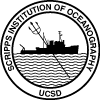
Ocean-Mixing
Experiment

|
Hawaii Ocean-Mixing Experiment | |||||
| HOME page | Historical Data | Modeling | Survey | Nearfield | Farfield | Scientist's Corner |
The HOME Farfield Experiment |
|
OverviewOcean acoustic tomography and TOPEX/POSEIDON (T/P)
altimetry have brought a new dimension to the subject
of the tides. We are presently working toward an energy
budget for the barotropic and low-mode baroclinic
tides in the farfield of the Hawaiian Ridge. The basic
energy equation is:
The HOME Farfield Experiment is supported by the National Science Foundation. The original proposal to NSF for the HOME Farfield Experiment can be downloaded from HERE. (700 KB) Field work was conducted between 2001 and 2002 to measure tidal pressure and currents with sufficient precision to better quantify the tidal power dissipated in the nearfield of the Ridge. Data to determine the radiation of internal tides into the farfield of Hawaii was also obtained using acoustic transmissions for tomography, hydrography, and thermistors. The analysis of these data are presently underway. For one month during the deployment of the southern array, the R/V FLIP (Floating Instrument Platform) was moored near the tomography mooring closest to the Hawaiian Ridge. The data collected during this expedition consisted of rapid hydrographic casts to 800 m to measure the internal wave field. These measurements give a better picture of the internal-tide "soup" that is emanating from the Hawaiian Ridge, e.g., the high-vertical-mode variability and incoherent components of tidal radiation. Click on an appropriate link to left for more information about the analysis for barotropic and baroclinic tides. |
 |
 |
 |
 |
|
| Email HOME Farfield Webmaster (Brian Dushaw) | ||||
|
This material is based upon work supported by the National Science Foundation under Grant No. 9819527. Any opinions, findings, and conclusions or recommendations expressed in this material are those of the authors and do not necessarily reflect the views of the National Science Foundation. |
||||